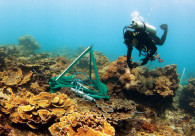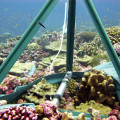
Clear vinyl pyramids are proving to be a valuable tool for checking reef health.
It may seem that Dr. Nichole Price has a job in paradise: cruising between remote tropical, often deserted, islands in the South Pacific, doing a bit of diving and pitching tents. As a postdoctoral researcher at the Scripps Institution of Oceanography at U.C. San Diego, she does all of these things, in an effort to document the effects of climate change on coral reefs.
The tents she sets up, though, are not the type for leisurely beach living: she uses a custom-made collapsible vinyl pyramid that makes a tight seal over reef structures and allows her to collect data.
“Essentially we’re using the tents like a stethoscope, where you can isolate an area of the reef. By looking at changes in the sea water chemistry contained within the tent, over a couple of days we can get an idea of the metabolic process,” she says. “We’re literally measuring the reef inhaling and exhaling on a daily basis, and using the tent as a tool to assess reef health.”
Material benefits
The tents Price and her team use aren’t a stock item picked up at the local REI. She looked at tents other researchers used, some as large as an Army barracks tent, and saw a lot of flaws: they were too bulky, covered too large a surface area, could not be placed in optimal study areas and simply did not stand up to the harsh conditions found in a reefenvironment.
“People have been trying for a while to figure out how to make these measurements,” she says, and she and her team set out to create a better piece of equipment. Prior to a research cruise in 2010, she approached a professional gadget designer at a neighboring university for help. Price couldn’t visualize the final product, but she had a list of must-have criteria for the incubation chamber.
“We told him we need it to be flexible so we can fold it up and scuba divers can swim it down,” she says. “We need to be able to unfold it and hammer it into the reef and be sure it will have the structural integrity to stay put and contain an area of reef.” She also wanted something reusable that would maintain its structural integrity against currents and swells, while not affecting data collection.
Mark Hatay, a retired physics technician from San Diego State University, lists “making toys” as his area of study with research labs that specialize in coral reefs. He’s a veteran of several underwater research trips, and knew what Price—and any equipment her team needed—was up against. He’s created numerous specialty pieces of equipment for research purposes, and estimates he uses some sort of fabric in about 20 percent of his designs.
“I work with any material that I can get my hands on,” Hatay says. “I look to all areas for expertise in how to use them. In my profession you have to use any and every material available. I even have metal cloth woven ofstainless steel wire for screening.”
Hatay suggested a tetrahedron design to withstand water pressure, and began researching materials that would not emit gas or contaminate the data collection in any way. To avoid rust, he chose aluminum poles, threaded with stainless steel wire that pulled the structure taut. Polycarbonate was chosen for the tent sides, because it would allow light to reach the coral for the necessary photosynthesis. About 90 percent of the structure is polycarbonate. The pyramid edges are made with green polyvinyl chloride, which not only keep the frame in place, but provide a flex point so the tent can fold into a flat triangle for easy transportation. The dimensions also add to its mobility: structure height is 29.4 inches, each side is 36 inches at the base, and it weighs 12.5 pounds on land. It’s stitched and glued together.
There is no base to the tent, but its edge has a polyvinyl skirt material that researchers tuck and weave into the surrounding loose coral to make as tight a seal as possible. A heavy-gauge stainless steel chain is then draped around the skirt to make the final seal. When in place, it has a footprint of about a half-meter squared, and the researchers place their monitoring equipment within the structure.
Hatay sewed the prototypes at home, and then took them to an area canvas shop to fabricate some parts and do other assembly work. He handed about 40 tents to Price, which were field-tested and put to work simultaneously.
Grade A, lessons learned
In the first deployment of the tents, it took six divers, a lot of underwater hand signals and some confusion to set them up, Price says. Three of the six tents were pulled from their moorings. “We learned that the material was much stronger than we had initially realized and that we could pull down tighter on the tents,” she said. “It’s really stable.”
“By the end of the cruise, it was like an assembly line,” she says. Two people would scout a location, two would pitch the tent and two would secure the skirt. Each tent would stay underwater for 24 to 72 hours, and get a good rinse with fresh water when back on shore.
“Setting it up is exactly like pitching a tent,” she says. They pound three stakes into the reef to secure the tent. Stainless steel wires pull through the aluminum frame and, because they’re pulling from the top, tighten it to the reef.
The tent ended up being so easy to set up that Price would consider a larger footprint for future designs. “We really struggled with balancing the size of the footprint being big enough to answer the ecological questions we were asking, but not so big that they would be impossible to handle underwater,” she said. “It was much easier to handle underwater than we’d anticipated, and we could go bigger: maybe up to a meter and a half on each side.”
Most importantly for Price and her team, the tents created the correct environment for the data she was seeking. “We were actually surprised that it worked,” she said. “It’s really rare when it does.”
Not that there aren’t lessons learned. In future models, she’d choose a different color polyvinyl because the chosen shade of green absorbed too much heat. She’d use a different adhesive or fusing method, because the polycarbonate and polyvinyl detached occasionally. The polycarbonate was also prone to scratching, which could be changed in future tents.
A design oversight left no planned location to insert tubing required to take water samples. “We were just lucky that the polyvinyl flaps that Mark selected had grommets to strap down the tent, and we could use one for our tubing,” she says. “I think Mark realized we’d need to be flexible in the field and choose materials that would do that.”
The tents from the original batch in 2010 will be packed again for a cruise in the fall of 2013. The tents won’t last indefinitely; Price estimates each can be used about 10 times before they show too much wear. “They are well worth the money for the use we get out of them,” she said.
A potential market?
While there may not be a mass market for these tents, Price says they’ve caught the attention of the research world—so much so that the tent now has a name: Collapsible Benthic Isolation Tent (cBIT).
“There are a lot of questions now about carbon dioxide production and sequestration, especially in terms of primary producers, whether on the land, sea or in fresh water,” she says. “It’s difficult to quantify how an existing miniature ecosystem functions and how it absorbs carbon dioxide during photosynthesis or releases it during respiration. I think this is an important question for biofuel production, ecosystem health or global health.”
“I can envision these tents over tidal pools or in low-flow freshwater streams or freshwater lakes, or even in small areas of grassland or forest to contain an area,” Price says. Other coral reef researchers are considering the tents for some large-scale projects.
Even so, neither she nor Hatay plan to get rich off of the tent. As scientists, they simply want to find the best approach possible to answer a question.
Lynn Keillor is a Minneapolis-based freelance writer and editor.






 TEXTILES.ORG
TEXTILES.ORG


